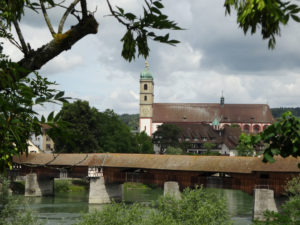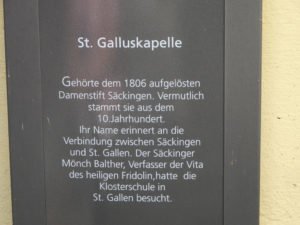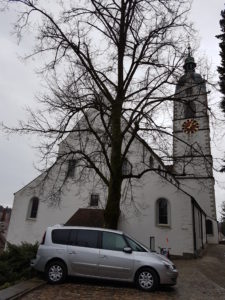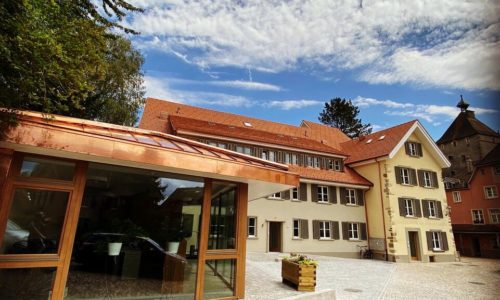Sehens- & Wissenswertes
| Km 2.5 | Beim Wasserkraftwerk Rheinfelden sperrt eine Staumauer den Rheinfluss. Wir lassen Möhlin rechts liegen und folgen weiter dem Rheinlauf. |
| Km 9.5 / 10.5 | Wir passieren zwei weitere Ruinen von römischen Wachttürmen. Dazwischen wandern wir entlang eines Naturschutzgebiets. Auf der gegenüberliegenden deutschen Seite des Rheins liegt Schwörstadt. Das Schloss ist von der Schweizerseite aus gut sichtbar. |
| Km 16 | In Mumpf ist die römisch-katholische Kirche St. Martin eine Besichtigung wert. Entstanden im 10. Jh wird sie 1302 erstmals erwähnt. |
| Km 19 | Wir durchqueren Stein. Die über 200m messende Holzbrücke ist die längste gedeckte Holzbrücke Europas. Sie verbindet Stein mit dem deutschen Bad Säckingen. Die historische Altstadt mit dem Fridolinsmünster lohnt einen Abstecher. Fridolin war der Sage nach Ire (538).
|
| Km 23 | Sisseln war ursprünglich ein Fischer- und Flösserdorf. Östlich des Dorfes befand sich ein befestigtes römisches Bauwerk. Da es seit der zweiten Hälfte des 4. Jh bestand, war es zu Zeiten von Kolumban bereits vorhanden.
Auf dem ganzen Weg dem Rhein entlang fallen immer wieder Bunker auf. Sie wurden im 2. Weltkrieg erbaut und dienten der Sicherung der schweizerischen Nordgrenze. |
| Km 29 | Der Etappenort Laufenburg ist erreicht. Der Rhein durchfliesst eine 12m breite Schlucht mit zahlreichen Strudeln. Aus dem Begriff „Laufen“ für Strudel ergaben sich die Namen für die beidseits des Rheins gelegenen Siedlungen.
|
















